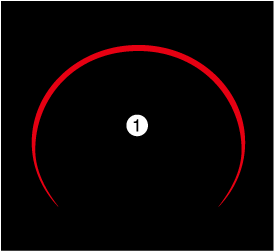

How to Use the Smart Brake Support (SBS)
During the SBS brake control, the brake pedal may move rearward or become stiff. The brakes are operating, but continue to depress the brake pedal.
When the forward detection function operates (Some Models)
The forward detection function operates when all of the following conditions are met and the system determines that there is the possibility of your vehicle colliding with a target object at the front.
-
(If an object is a vehicle ahead/motorcycles)
-
The vehicle speed is about 4 km/h (3 mph) or faster.
-
-
(If an object is a bicycle/pedestrian)
-
The vehicle speed is about 10 km/h to 80 km/h (6.3 mph to 49 mph).
-
-
The DSC does not operate.
When the forward detection function operates, the driver is notified of the danger by the screen display and warning sound. Furthermore, if the possibility of a collision increases, brake control is performed.
Instrument cluster

-
“BRAKE!”
Active driving display

-
“BRAKE!”
-
If any of the following conditions is met, the forward detection function may not operate normally.
-
The Forward Sensing Camera (FSC) cannot detect target objects.
Refer to Forward Sensing Camera (FSC) (Search).
-
The front radar sensor cannot detect target objects.
Refer to Radar Sensors (Search).
-
When there is the possibility of a partial contact with a target object.
-
The driver deliberately performs driving operations (accelerator pedal operation, steering wheel operation, selector lever operation, and turn signal lever operation).
-
-
If any of the following conditions is met, the forward detection function may operate.
-
An animal or object on the road is detected.
-
Passing an approaching vehicle while rounding a curve.
-
Vehicle is passing through a narrow gate or a gate with a low ceiling.
-
There is a metal object, bump, or a protruding object on the road.
-
-
(Vehicles with Driver Monitoring (DM))
If the system determines that the driver is not paying attention to the road, it activates the collision warning earlier than normal.
-
If the forward detection function performs brake control and the vehicle is stopped, the system will continue to hold the brakes for a brief time unless there is an operation performed by the driver.
-
The operation distance and volume of the collision warning can be changed.
Set using “Settings” on the Mazda Connect home screen or consult an Authorized Mazda Dealer.
When the rearward detection function operates (Some Models)
The rearward detection function operates when the vehicle speed is between about 2 km/h to 15 km/h (2 mph to 9.3 mph) and the system determines that there is the possibility of your vehicle colliding with a target object at the rear.
When the rearward detection function operates, the screen display and warning sound notify the driver of the danger. Furthermore, if the possibility of a collision increases, brake control is performed.
Instrument cluster

-
“BRAKE!”
Active driving display

-
“BRAKE!”
-
The rear ultrasonic sensors may not be able to detect target objects correctly, and the rearward detection function may not operate normally.
Refer to Ultrasonic Sensors (Search).
-
If any of the following conditions is met, the rearward detection function may operate.
-
There is a hanging curtain.
-
Vehicle is passing through a narrow gate or a gate with a low ceiling.
-
There is a metal object, bump, or a protruding object on the road.
-
-
If the rearward detection function performs brake control and the vehicle is stopped, the system will continue to hold the brakes for a brief time unless there is an operation performed by the driver.
When the Rear Crossing is operating (Some Models)
The Rear Crossing detection function operates when the vehicle speed is about 15 km/h (9.3 mph) or slower and the system determines that there is the possibility of your vehicle colliding with a vehicle approaching from a rear side.
When the Rear Crossing operates, the screen display and warning sound notify the driver is notified of the danger. Furthermore, if the possibility of a collision increases, brake control is performed.
Instrument cluster

-
“BRAKE!”
Active driving display

-
“BRAKE!”
-
If any of the following conditions is met, the Rear Crossing may not operate normally.
-
The rear side radar sensors cannot detect an object.
Refer to Radar Sensors (Search).
-
A vehicle is approaching directly from the rear of your vehicle.
-
A vehicle is approaching at an angle from the rear of your vehicle.
-
A vehicle is approaching from a direction at an acute angle.
-
-
If any of the following conditions is met, the Rear Crossing may operate.
-
There is a hanging curtain.
-
Vehicle is passing through a narrow gate or a gate with a low ceiling.
-
-
If the Rear Crossing performs brake control and the vehicle is stopped, the system will continue to hold the brakes for a brief time unless there is an operation performed by the driver.
Turning off the SBS
The SBS can be turned off using the Mazda Connect.
Set using “Settings” on the Mazda Connect home screen or consult an Authorized Mazda Dealer.
When the SBS is turned off, the SBS OFF indicator  turns on.
turns on.


